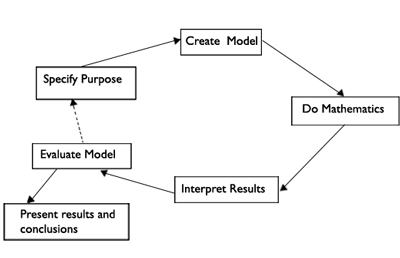Mathematical Modelling Activity
Mathematical modelling, often referred to as the modelling cycle, can be represented by a diagram:

The key stages in this modelling process can be summarized as:
- SPECIFY THE PURPOSE - define the problem and decide on the aspects of the problem to investigate. .
- CREATE THE MODEL - state simplifying assumptions; choose variables and parameters and formulate mathematical relationships.
- DO THE MATHEMATICS - solve equations, draw graphs and derive results.
- INTERPRET RESULTS - describe mathematical solution in words; perform sensitivity analysis; decide what results to compare with reality and collect relevant data.
- EVALUATE THE MODEL - test the model by comparing it with reality and criticise the model.
If you are satisfied with the results of your evaluation of the model, then you can present the results and conclusions verbally or in a report. On the other hand, if your model is not satisfactory, you may need to go round the mathematical cycle again, refining your model in the light of the criticisms made.
The file below takes you through the solution of a problem using this cycle. As you work through it, think how the different stages relate to the modelling cycle and whether there are any aspects of this process that you need to do further work on.
The file contains a link to a small java application. You may need to download the Java runtime Environment to run it. This can be downloaded from the Java home page. If you wish to work offline you will need to download and save the application as well as the Adobe Acrobat file above. Save the application in the same folder as you place the Adobe Acrobat file. This application is a mild enhancement of the activity. You can still work through the activity without it.
Download activity "The curtain pole problem" (Adobe Acrobat file)